Trichoderma atroviride Enhances Impatiens walleriana Hook. f Growth and Flowering in Different Growing Media
Abstract
1. Introduction
2. Results
2.1. Biomass Measures
2.2. Mineral Elements
2.3. Leaf Pigments and Trichoderma Analysis
2.4. Principal Component Analysis (PCA)
3. Discussion
4. Materials and Methods
4.1. Plant Material and Growing Condition
4.2. Plant Biomass Measures
4.3. Tissue Analyses
4.4. Trichoderma atroviride Analysis
4.5. Statistical Analysis
5. Conclusions
Supplementary Materials
Author Contributions
Funding
Data Availability Statement
Acknowledgments
Conflicts of Interest
References
- Gabellini, S.; Scaramuzzi, S. Evolving consumption trends, marketing strategies, and governance settings in ornamental horticulture: A grey literature review. Horticulturae 2022, 8, 234. [Google Scholar] [CrossRef]
- Guarnaccia, V.; Hand, F.P.; Garibaldi, A.; Gullino, M.L. Bedding plant production and the challenge of fungal diseases. Plant Dis. 2021, 105, 1241–1258. [Google Scholar] [CrossRef] [PubMed]
- USDA. Floriculture Crops: 2018 Summary. United States Department of Agriculture–National Agricultural Statistics Service. 2019. Available online: https://www.nass.usda.gov/Publications/Todays_Reports/reports/floran19.pdf (accessed on 16 February 2024).
- European Commission Working Document. Horticultural Products Flowers and Ornamental Plants Statistic 2010–2019. DGAGRI-G2 2020. Available online: https://agriculture.ec.europa.eu/system/files/2020-06/flowers-ornamental-plants-statistics_en_0.pdf (accessed on 16 February 2024).
- Pardossi, A.; Carmassi, G.; Diara, C.; Incrocci, L.; Maggini, R.; Massa, D. Fertigation and Substrate Management in Closed Soilless Culture; University of Pisa: Pisa, Italy, 2011. [Google Scholar]
- Savvas, D.; Gruda, N. Application of soilless culture technologies in the modern greenhouse industry—A review. Eur. J. Hortic. Sci. 2018, 83, 280–293. [Google Scholar] [CrossRef]
- Gruda, N.S. Increasing sustainability of growing media constituents and stand-alone substrates in soilless culture systems. Agronomy 2019, 9, 298. [Google Scholar] [CrossRef]
- Schmilewski, G. Growing medium constituents used in the EU. In Proceedings of the International Symposium on Growing Media 2007, Nottingham, UK, 2–8 September 2007; International Society for Horticultural Science (ISHS): Leuven, Belgium, 2009; pp. 33–46. [Google Scholar] [CrossRef]
- Schmilewski, G. Growing media constituents used in the EU in 2013. In Proceedings of the International Symposium on Growing Media, Composting and Substrate Analysis—SusGro2015, Vienna, Austria, 7–11 September 2015; International Society for Horticultural Science (ISHS): Leuven, Belgium, 2017; pp. 85–92. [Google Scholar] [CrossRef]
- Toboso-Chavero, S.; Madrid-López, C.; Villalba, G.; Gabarrell Durany, X.; Hückstädt, A.B.; Finkbeiner, M.; Lehmann, A. Environmental and social life cycle assessment of growing media for urban rooftop farming. Int. J. LCA 2021, 26, 2085–2102. [Google Scholar] [CrossRef]
- Abad, M.; Noguera, P.; Puchades, R.; Maquieira, A.; Noguera, V. Physico-chemical and chemical properties of some coconut coir dusts for use as a peat substitute for containerised ornamental plants. Bioresour. Technol. 2002, 82, 241–245. [Google Scholar] [CrossRef]
- Atzori, G.; Pane, C.; Zaccardelli, M.; Cacini, S.; Massa, D. The role of peat-free organic substrates in the sustainable management of soilless cultivations. Agronomy 2021, 11, 1236. [Google Scholar] [CrossRef]
- Stewart-Wade, S.M. Efficacy of organic amendments used in containerized plant production: Part 2—Non-compost-based amendments. Sci. Hortic. 2020, 260, 108855. [Google Scholar] [CrossRef]
- Rhie, Y.-H.; Nam, S.; Kim, J. Seed germination and seedling growth of four bedding plants in substrate containing coal bottom ash mixed with coir dust. Agronomy 2021, 11, 1902. [Google Scholar] [CrossRef]
- Nelson, P.V.; Oh, Y.-M.; Cassel, D.K. Changes in physical properties of coir dust substrates during crop production. Acta Hortic. 2004, 644, 261–268. [Google Scholar] [CrossRef]
- Carlile, W.R.; Raviv, M.; Prasad, M. Organic Soilless Media Components. In Soilless Culture; Raviv, M., Lieth, J.H., Bar-Tal, A., Eds.; Academic Press: Cambridge, MA, USA, 2019; pp. 303–378. [Google Scholar] [CrossRef]
- Van Gerrewey, T.; Ameloot, N.; Navarrete, O.; Vandecruys, M.; Perneel, M.; Boon, N.; Geelen, D. Microbial activity in peat-reduced plant growing media: Identifying influential growing medium constituents and physicochemical properties using fractional factorial design of experiments. J. Clean. Prod. 2020, 256, 120323. [Google Scholar] [CrossRef]
- Dewi, T.K.; Mubarok, W.Z.; Antonius, S. Study of plant growth promoting bacteria from coconut coir dust. IOP Conf. Ser. Earth Environ. Sci. 2020, 439, 012037. [Google Scholar] [CrossRef]
- Chromkaew, Y.; Kaeomuangmoon, T.; Mawan, N.; Mukjang, N.; Khongdee, N. Is coconut coir dust an efficient biofertilizer carrier for promoting coffee seedling growth and nutrient uptake? PeerJ 2023, 11, e15530. [Google Scholar] [CrossRef] [PubMed]
- Bardin, M.; Pugliese, M. Biocontrol agents against diseases. In Integrated Pest and Disease Management in Greenhouse Crops. Plant Pathology in the 21st Century; Gullino, M., Albajes, R., Nicot, P., Eds.; Springer: Cham, Switzerland, 2020; Volume 9, pp. 385–407. [Google Scholar] [CrossRef]
- Saini, I.; Aggarwal, A.; Kaushik, P. Inoculation with mycorrhizal fungi and other microbes to improve the morpho-physiological and floral traits of Gazania rigens (L.) Gaertn. Agriculture 2019, 9, 51. [Google Scholar] [CrossRef]
- Kubicek, C.P.; Bissett, J.; Druzhinina, I.; Kullnig-Gradinger, C.M.; Szakacs, G. Genetic and metabolic diversity of Trichoderma: A case study on South East Asian isolates. Fungal Genet. Biol. 2003, 38, 310–319. [Google Scholar] [CrossRef]
- Hewedy, O.A.; Abdel Lateif, K.S.; Seleiman, M.F.; Shami, A.; Albarakaty, F.M.M.; El-Meihy, R. Phylogenetic diversity of Trichoderma strains and their antagonistic potential against soil-borne pathogens under stress conditions. Biology 2020, 9, 189. [Google Scholar] [CrossRef]
- Cardarelli, M.; Woo, S.L.; Rouphael, Y.; Colla, G. Seed treatments with microorganisms can have a biostimulant effect by influencing germination and seedling growth of crops. Plants 2022, 11, 259. [Google Scholar] [CrossRef]
- Colla, G.; Rouphael, Y.; Di Mattia, E.; El-Nakhel, C.; Cardarelli, M. Co-inoculation of Glomus intraradices and Trichoderma atroviride acts as a biostimulant to promote growth, yield and nutrient uptake of vegetable crops. J. Sci. Food Agric. 2015, 95, 1706–1715. [Google Scholar] [CrossRef]
- Guzmán-Guzmán, P.; Kumar, A.; De Los Santos-Villalobos, S.; Parra-Cota, F.I.; Orozco-Mosqueda, M.; Fadiji, A.E.; Hyder, S.; Babalol, O.O.; Santoyo, G. Trichoderma species: Our best fungal allies in the biocontrol of plant diseases—A review. Plants 2023, 12, 432. [Google Scholar] [CrossRef]
- Harman, G.E.; Howell, C.R.; Viterbo, A.; Chet, I.; Lorito, M. Trichoderma species—Opportunistic, avirulent plant symbionts. Nat. Rev. Microbiol. 2004, 2, 43–56. [Google Scholar] [CrossRef]
- Bonini, P.; Rouphael, Y.; Cardarelli, M.; Ceccarelli, A.V.; Colla, G. Effectiveness of Trichoderma application through drip-irrigation to reduce Sclerotinia disease incidence and improve the growth performance of greenhouse lettuce. Acta Hortic. 2020, 1268, 199–204. [Google Scholar] [CrossRef]
- Sabatino, L.; Consentino, B.B.; Ntatsi, G.; La Bella, S.; Baldassano, S.; Rouphael, Y. Stand-alone or combinatorial effects of grafting and microbial and non-microbial derived compounds on vigour, yield and nutritive and functional quality of greenhouse eggplant. Plants 2022, 11, 1175. [Google Scholar] [CrossRef] [PubMed]
- Tucci, M.; Ruocco, M.; De Masi, L.; De Palma, M.; Lorito, M. The beneficial effect of Trichoderma spp. on tomato is modulated by the plant genotype. Mol. Plant Pathol. 2011, 12, 341–354. [Google Scholar] [CrossRef] [PubMed]
- Regliński, T.; Rodenburg, N.; Taylor, J.T.; Northcott, G.L.; Ah Chee, A.; Spiers, T.M.; Hill, R.A. Trichoderma atroviride promotes growth and enhances systemic resistance to Diplodia pinea in radiata pine (Pinus radiata) seedlings. For. Pathol. 2012, 42, 75–78. [Google Scholar] [CrossRef]
- Esparza-Reynoso, S.; Ruíz-Herrera, L.F.; Pelagio-Flores, R.; Macías-Rodríguez, L.I.; Martínez-Trujillo, M.; López-Coria, M.; Sánchez-Nieto, S.; Herrera-Estrella, A.; López-Bucio, J. Trichoderma atroviride-emitted volatiles improve growth of Arabidopsis seedlings through modulation of sucrose transport and metabolism. Plant Cell Environ. 2021, 44, 1961–1976. [Google Scholar] [CrossRef]
- Contreras-Cornejo, H.A.; López-Bucio, J.S.; Méndez-Bravo, A.; Macías-Rodríguez, L.; Ramos-Vega, M.; Guevara-García, Á.A.; López-Bucio, J. Mitogen-activated protein kinase 6 and ethylene and auxin signaling pathways are involved in Arabidopsis root-system architecture alterations by Trichoderma atroviride. Mol. Plant-Microbe Interact. 2015, 28, 7011–7710. [Google Scholar] [CrossRef]
- Dautt-Castro, M.; Estrada-Rivera, M.; Olguin-Martínez, I.; Del Carmen Rocha-Medina, M.; Islas-Osuna, M.A.; Casas-Flores, S. TBRG-1 a Ras-like protein in Trichoderma virens involved in conidiation, development, secondary metabolism, mycoparasitism, and biocontrol unveils a new family of Ras-GTPases. Fungal Genet. Biol. 2020, 136, 103292. [Google Scholar] [CrossRef]
- Zin, N.A.; Badaluddin, N.A. Biological functions of Trichoderma spp. for agriculture applications. Ann. Agric. Sci. 2020, 65, 168–178. [Google Scholar] [CrossRef]
- Andrzejak, R.; Janowska, B. Trichoderma spp. improves flowering, quality, and nutritional status of ornamental plants. Int. J. Mol. Sci. 2022, 23, 15662. [Google Scholar] [CrossRef] [PubMed]
- Andrzejak, R.; Janowska, B. Flowering, nutritional status, and content of chloroplast pigments in leaves of Gladiolus hybridus L. ‘Advances Red’ after application of Trichoderma spp. Sustainability 2022, 14, 4576. [Google Scholar] [CrossRef]
- Mazhabi, M.; Nemati, H.; Rouhani, H.; Tehranifar, A.; Mahdikhani-Moghadam, E.; Kaveh, H. Does Trichoderma harzianum really increase growth parameters in plants? Res. J. Biol. Sci. 2010, 5, 739–744. [Google Scholar] [CrossRef]
- Mazhabi, M.; Nemati, H.; Rouhani, H.; Tehranifar, A.; Moghadam, E.M.; Kaveh, H.; Rezaee, A. The effect of Trichoderma on polianthes qualitative and quantitative properties. J. Anim. Plant Sci. 2011, 21, 617–621. [Google Scholar]
- Yahya, A.B.; Al-Sawaf, M.D.; Al-Morad, N.Y. Effect of biofertilizer Trichoderma harzianum t-22 application, growing medium and training methods on some characteristics for Lantana camara plants. Mesop. J. Agric. 2021, 49, 95–103. [Google Scholar] [CrossRef]
- Andrzejak, R.; Janowska, B.; Reńska, B.; Kosiada, T. Effect of Trichoderma spp. and fertilization on the flowering of Begonia × tuberhybrida Voss. ‘Picotee Sunburst’. Agronomy 2021, 11, 1278. [Google Scholar] [CrossRef]
- Prisa, D.; Sarrocco, S.; Forti, M.; Burchi, G.; Vannacci, G. Endophytic ability of Trichoderma spp. as inoculants for ornamental plants innovative substrates. J. Biocontrol Plant Pathog. Sustain. Agric. IOBC–WPRS Bull. 2013, 86, 169–174. [Google Scholar]
- Ousley, M.A.; Lynch, J.M.; Whipps, J.M. The effects of addition of Trichoderma inocula on flowering and shoot growth of bedding plants. Sci. Hortic. 1994, 59, 147–155. [Google Scholar] [CrossRef]
- Contreras-Cornejo, H.A.; Macías-Rodríguez, L.; Cortés-Penagos, C.; López-Bucio, J. Trichoderma virens, a plant beneficial fungus, enhances biomass production and promotes lateral root growth through an auxin-dependent mechanism in Arabidopsis. Plant Physiol. 2009, 149, 1579–1592. [Google Scholar] [CrossRef] [PubMed]
- Lorito, M.; Woo, S.L.; Harman, G.E.; Monte, E. Translational research on Trichoderma: From ’omics to the field. Annu. Rev. Phytopathol. 2010, 48, 395–417. [Google Scholar] [CrossRef] [PubMed]
- Stewart, A.; Hill, R. Applications of Trichoderma in plant growth promotion. In Biotechnology and Biology of Trichoderma; Gupta, V.G., Schmoll, M., Herrera-Estrella, A., Upadhyay, R.S., Druzhinina, I., Tuohy, M., Eds.; Elsevier: Amsterdam, The Netherlands, 2014; pp. 415–428. [Google Scholar] [CrossRef]
- Janowska, B.; Andrzejak, R.; Kosiada, T. The influence of fungi of the Trichoderma genus on the flowering of Freesia refracta Klatt ‘Argentea’ in winter. Hortic. Sci. 2020, 47, 203–210. [Google Scholar] [CrossRef]
- Abdel-Fattah, G.M.; Shabana, Y.M.; Ismail, A.E.; Rashad, Y.M. Trichoderma harzianum: A biocontrol agent against Bipolaris oryzae. Mycopathologia 2007, 164, 81–89. [Google Scholar] [CrossRef]
- Harman, G.E.; Doni, F.; Khadka, R.B.; Uphoff, N. Endophytic strains of Trichoderma increase plants’ photosynthetic capability. J. Appl. Microbiol. 2021, 130, 529–546. [Google Scholar] [CrossRef] [PubMed]
- Metwally, R.A.; Al-Amri, S.M. Individual and interactive role of Trichoderma viride and arbuscular mycorrhizal fungi on growth and pigment content of onion plants. Lett. Appl. Microbiol. 2020, 70, 79–86. [Google Scholar] [CrossRef] [PubMed]
- Sriram, S.; Savitha, M.J.; Ramanujam, B. Trichoderma-enriched coco-peat for the management of Phytophthora and Fusarium diseases of chilli and tomato in nurseries. J. Biol. Control 2010, 24, 311–316. [Google Scholar]
- Terrosi, C.; Cacini, S.; Burchi, G.; Cutini, M.; Brambilla, M.; Bisaglia, C.; Massa, D.; Fedrizzi, M. Evaluation of compressor heat pump for root zone heating as an alternative heating source for leafy vegetable cultivation. Energies 2020, 13, 745. [Google Scholar] [CrossRef]
- EN 13037/1999; Soil Improvers and Growing Media—Determination of pH. CEN, European Committee for Standardization: Brussels, Belgium, 1999.
- EN 13038/1999; Soil Improvers and Growing Media—Determination of Electrical Conductivity. CEN, European Committee for Standardization: Brussels, Belgium, 1999.
- De Boodt, M.; Verdonck, O. The physical properties of the substrates in horticulture. In Proceedings of the III Symposium on Peat in Horticulture 26, Dublin, Ireland, 28 June–3 July 1971; pp. 37–44. [Google Scholar]
- Lichtenthaler, H.K.; Buschmann, C. Chlorophylls and carotenoids: Measurement and characterization by UV-VIS spectroscopy. Curr. Protoc. Food Anal. Chem. 2001, 1, F4.3.1–F4.3.8. [Google Scholar] [CrossRef]
- Massa, D.; Prisa, D.; Montoneri, E.; Battaglini, D.; Ginepro, M.; Negre, M.; Burchi, G. Application of municipal biowaste derived products in Hibiscus cultivation: Effect on leaf gaseous exchange activity and plant biomass accumulation and quality. Sci. Hortic. 2016, 205, 59–69. [Google Scholar] [CrossRef]
- Cataldo, D.A.; Maroon, M.; Schrader, L.E.; Youngs, V.L. Rapid colorimetric determination of nitrate in plant tissue by nitration of salicylic acid. Commun. Soil Sci. Plant Anal. 1975, 6, 71–80. [Google Scholar] [CrossRef]
- Fiorentino, N.; Ventorino, V.; Woo, S.L.; Pepe, O.; De Rosa, A.; Gioia, L.; Romano, I.; Lombardi, N.; Napolitano, M.; Colla, G.; et al. xi-based biostimulants modulate rhizosphere microbial populations and improve N uptake efficiency, yield, and nutritional quality of leafy vegetables. Front. Plant Sci. 2018, 9, 743. [Google Scholar] [CrossRef] [PubMed]
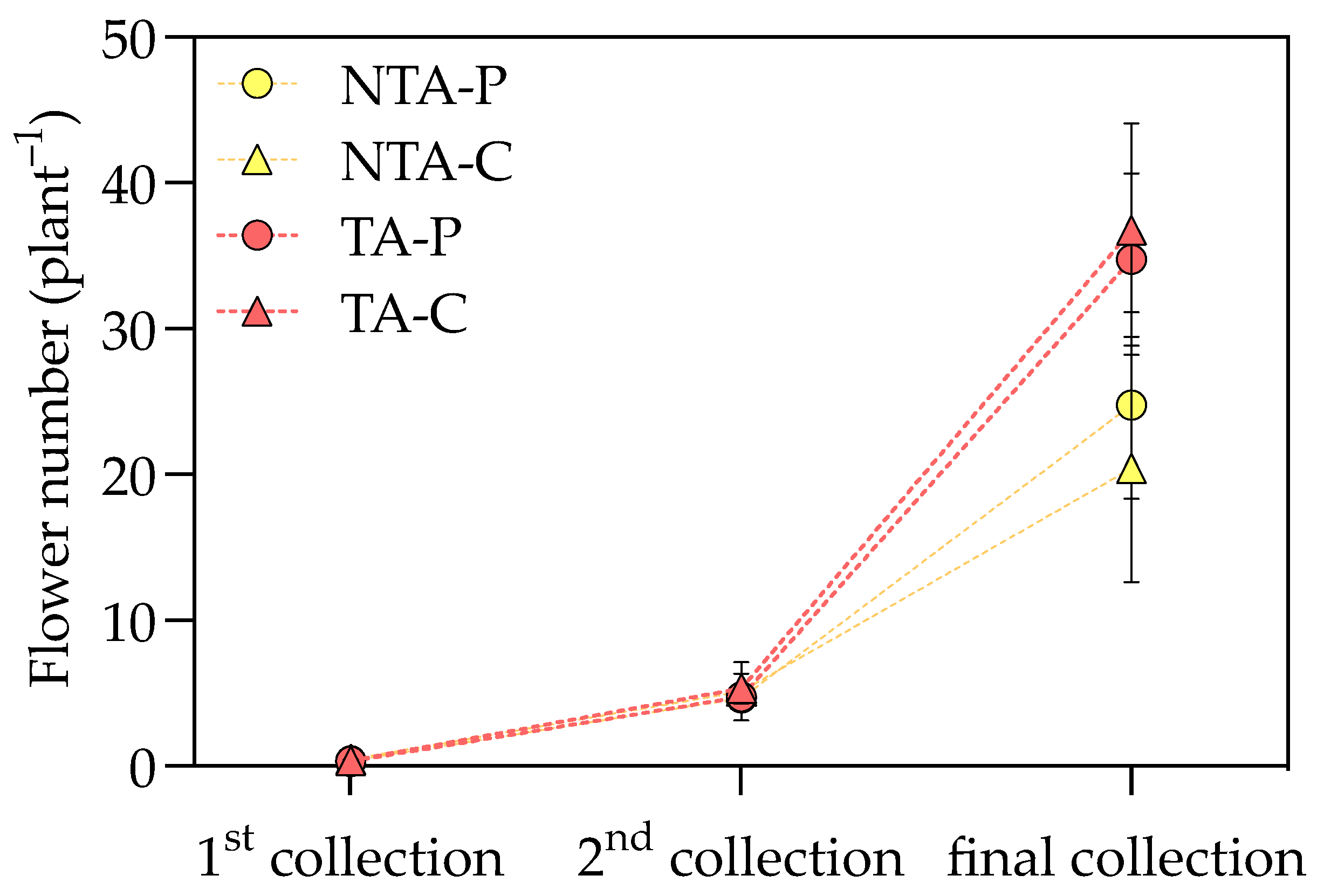
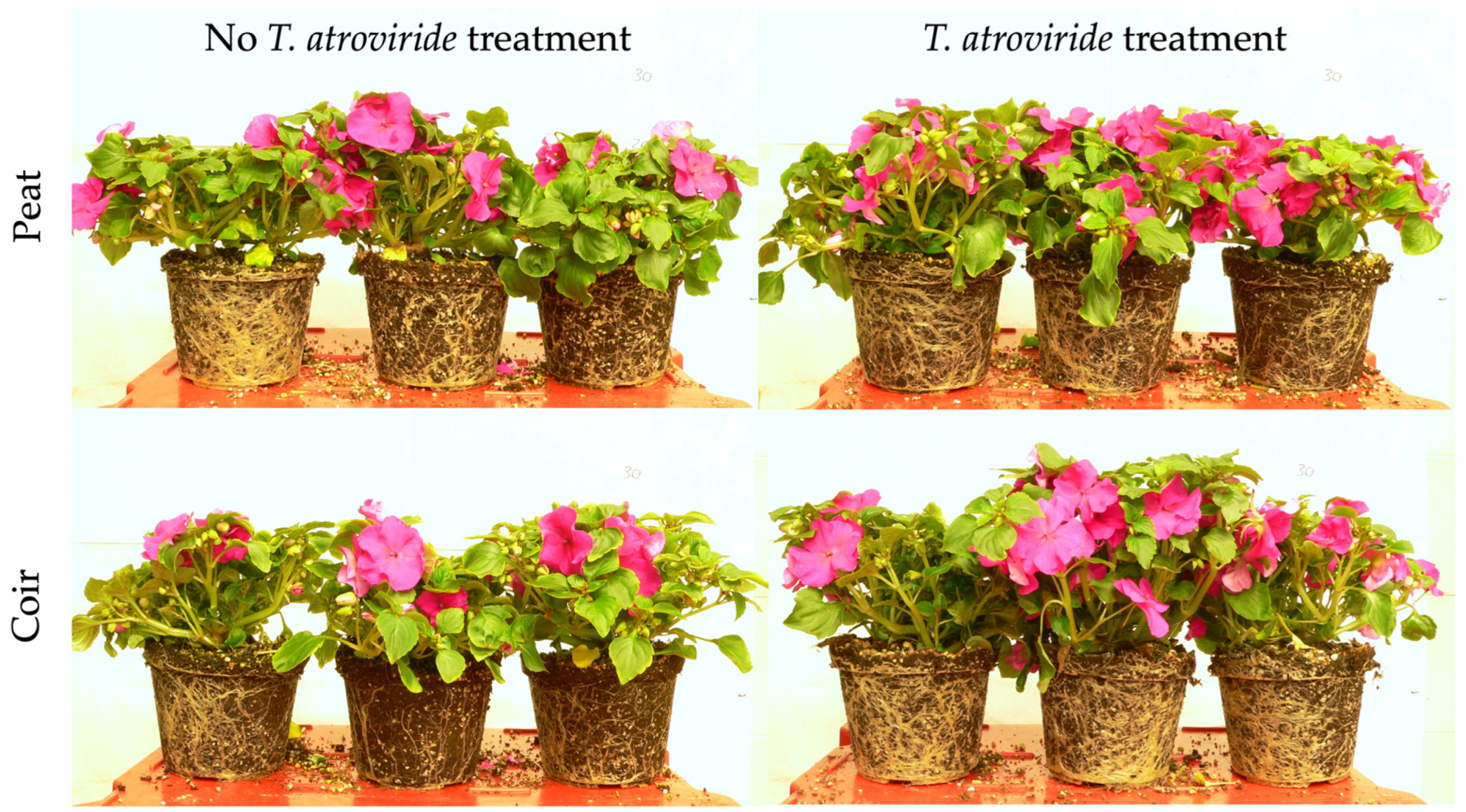
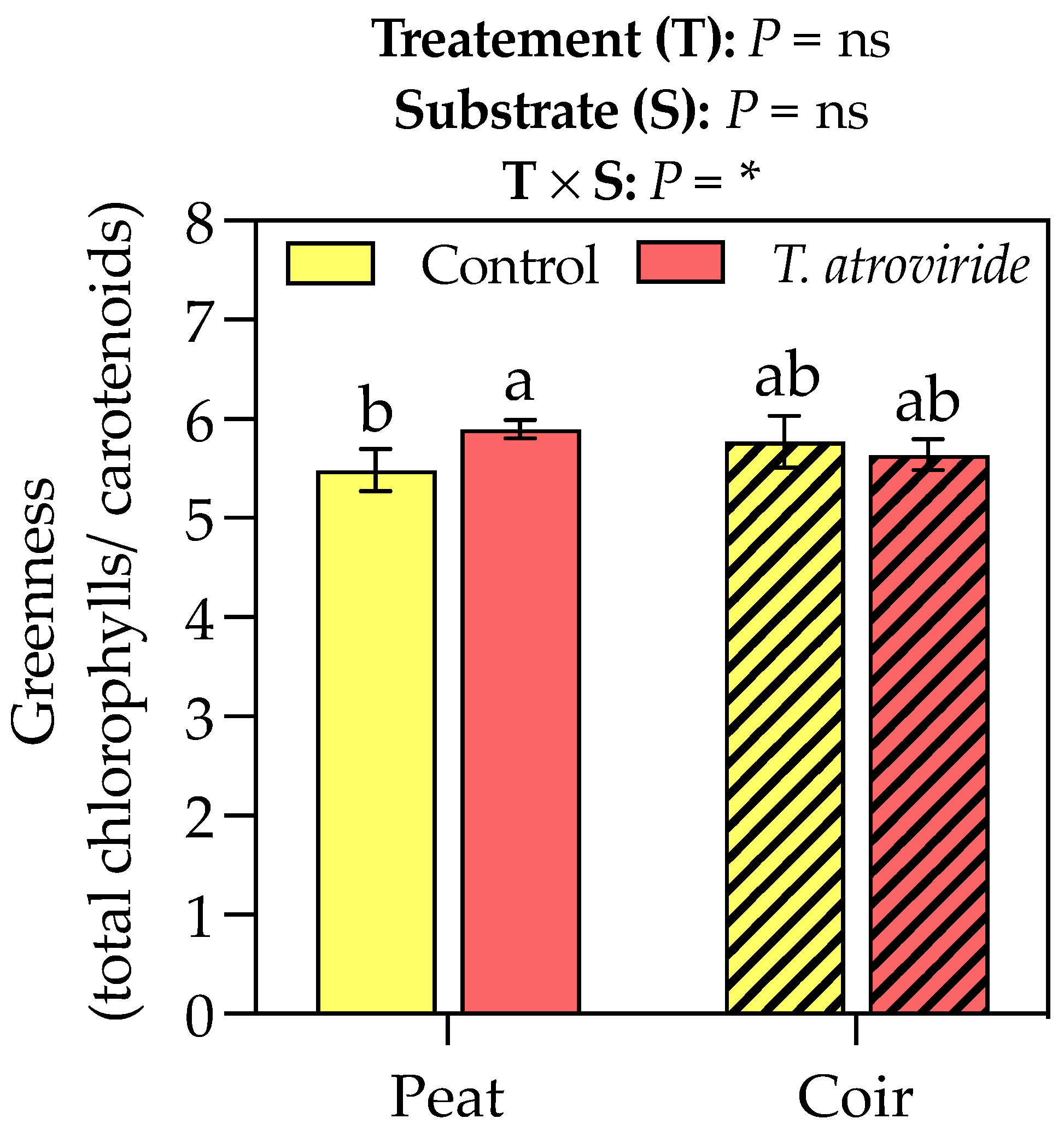
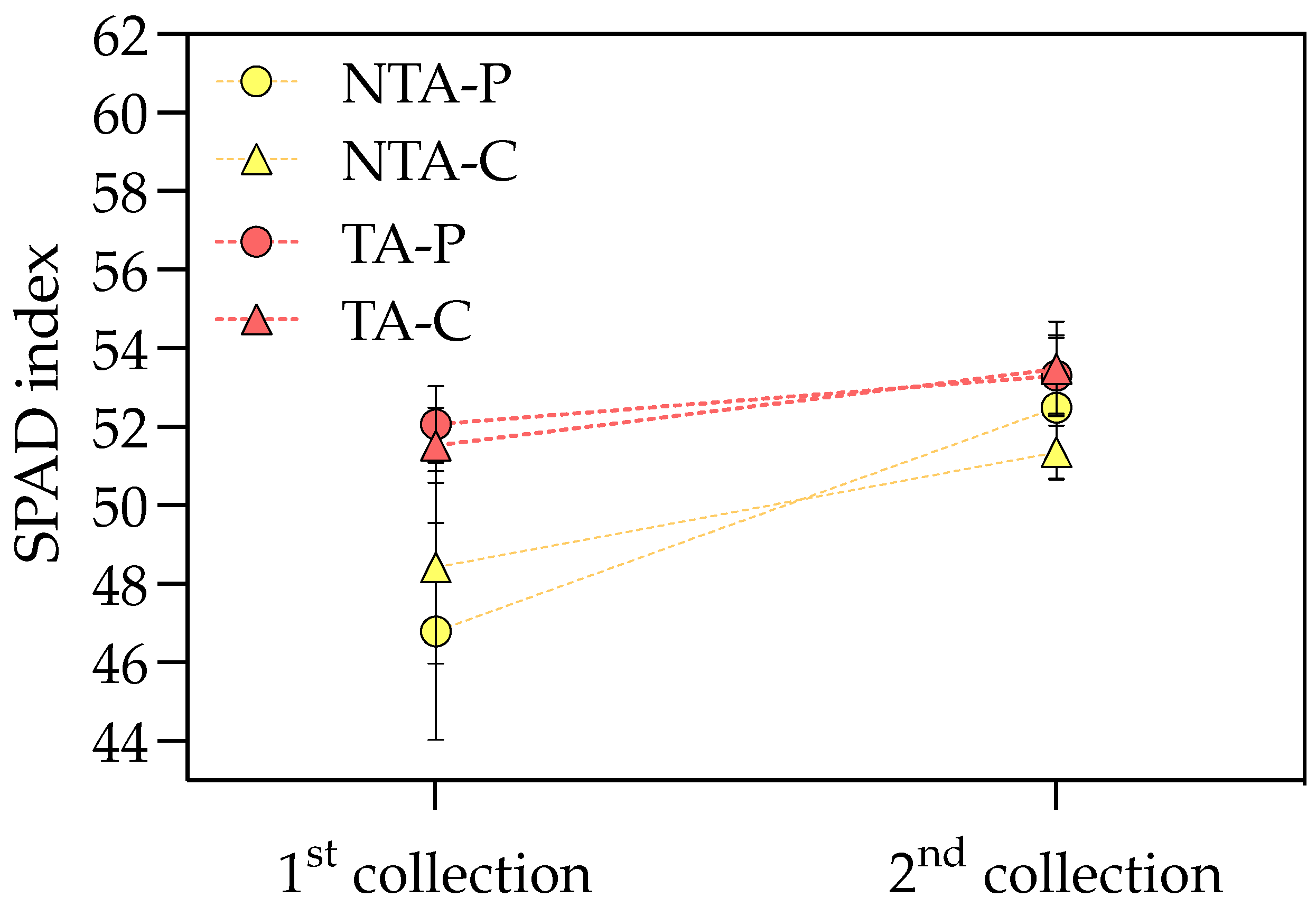
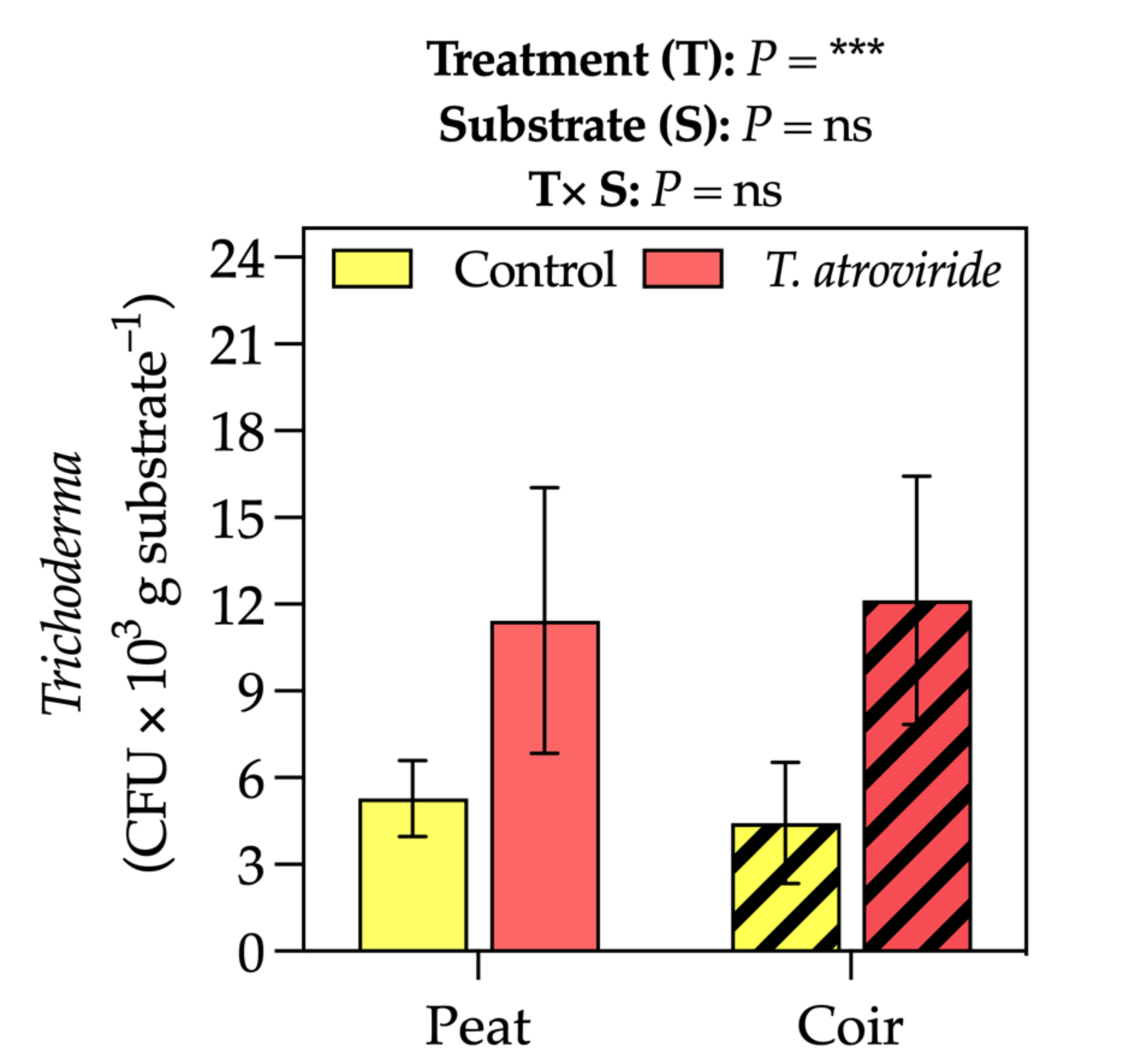
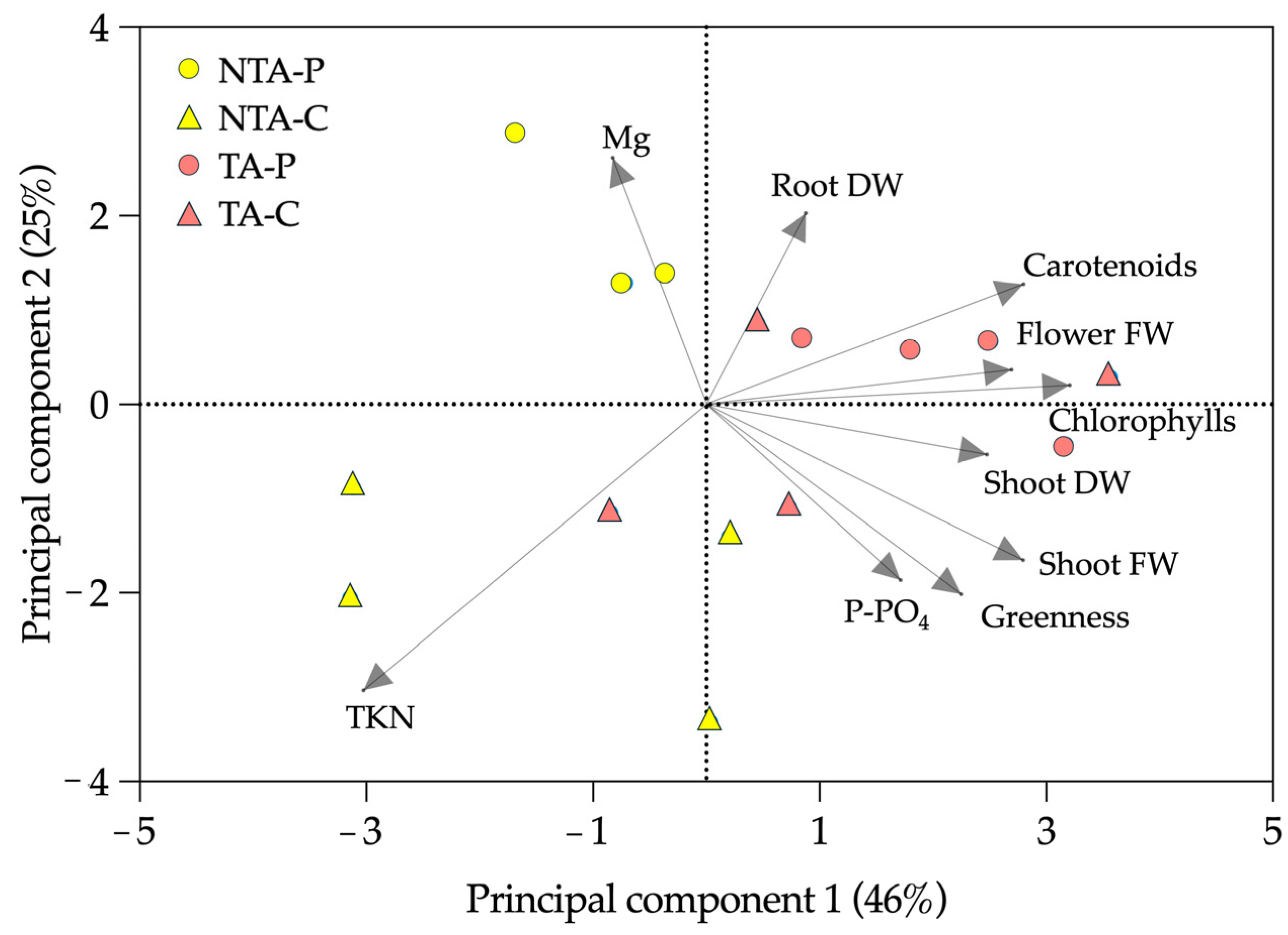
| Source of Variation | Shoot FW (g plant−1) | Shoot DW (g plant−1) | Total Flower FW (g plant−1) | Total Flower Number (plant−1) | Leaf Area (cm2 plant−1) | Root DW (g plant−1) |
|---|---|---|---|---|---|---|
| Treatment (T) | ||||||
| No T. atroviride (NTA) | 109 ± 13.7 | 5.1 ± 0.44 | 20.2 ± 7.41 | 28.0 ± 8.21 | 2850 ± 415.6 | 1.4 ± 0.20 |
| T. atroviride (TA) | 135 ± 12.9 | 5.9 ± 0.77 | 27.0 ± 2.41 | 41.2 ± 5.70 | 3519 ± 343.6 | 1.6 ± 0.17 |
| p-value | ** | * | * | ** | ** | ns |
| Substrate (S) | ||||||
| Peat (P) | 117 ± 19.4 | 5.5 ± 0.94 | 24.4 ± 5.33 | 34.8 ± 7.92 | 3098 ± 569.2 | 1.6 ± 0.16 |
| Coir (C) | 126 ± 18.0 | 5.4 ± 0.51 | 22.8 ± 7.57 | 34.3 ± 11.7 | 3270 ± 453.3 | 1.4 ± 0.14 |
| p-value | ns | ns | ns | ns | ns | ** |
| T × S | ||||||
| NTA × P | 101 ± 9.7 | 4.9 ± 0.35 | 22.5 ± 6.96 | 29.8 ± 6.86 | 2679 ± 442.4 | 1.6 ± 0.18 |
| NTA × C | 116 ± 14.4 | 5.2 ± 0.50 | 17.9 ± 8.10 | 26.1 ± 10.0 | 3021 ± 359.8 | 1.3 ± 0.12 |
| TA × P | 133 ± 11.2 | 6.2 ± 0.90 | 26.4 ± 2.79 | 39.9 ± 5.65 | 3517 ± 302.4 | 1.7 ± 0.14 |
| TA × C | 137 ± 15.9 | 5.5 ± 0.56 | 27.7 ± 2.14 | 42.5 ± 6.28 | 3520 ± 428.9 | 1.5 ± 0.13 |
| p-value | ns | ns | ns | ns | ns | ns |
| Source of Variation | TKN | P-PO4 | K | Ca | Mg |
|---|---|---|---|---|---|
| Treatment (T) | |||||
| No T. atroviride (NTA) | 42.6 ± 2.13 | 7.6 ± 0.50 | 38.7 ± 2.00 | 28.5 ± 0.82 | 5.7 ± 0.51 |
| T. atroviride (TA) | 40.8 ± 0.99 | 8.1 ± 0.44 | 42.1 ± 2.77 | 30.3 ± 0.76 | 5.6 ± 0.28 |
| p-value | ** | * | * | ** | ns |
| Substrate (S) | |||||
| Peat (P) | 40.9 ± 1.07 | 7.7 ± 0.61 | 39.2 ± 2.48 | 29.4 ± 0.67 | 5.9 ± 0.32 |
| Coir (C) | 42.6 ± 2.16 | 8.0 ± 0.41 | 41.6 ± 2.92 | 29.5 ± 1.68 | 5.4 ± 0.28 |
| p-value | * | ns | ns | ns | * |
| T × S | |||||
| NTA × P | 41.0 ± 1.56 b | 7.3 ± 0.36 | 37.5 ± 1.48 | 28.9 ± 0.64 bc | 6.1 ± 0.30 |
| NTA × C | 44.3 ± 0.80 a | 7.9 ± 0.47 | 40.0 ± 1.63 | 28.1 ± 0.85 c | 5.3 ± 0.30 |
| TA × P | 40.8 ± 0.48 b | 8.1 ± 0.56 | 40.9 ± 2.03 | 29.8 ± 0.36 ab | 5.7 ± 0.23 |
| TA × C | 40.8 ± 1.44 b | 8.2 ± 0.38 | 43.2 ± 3.34 | 30.8 ± 0.71 a | 5.5 ± 0.30 |
| p-value | * | ns | ns | * | ns |
| Source of Variation | Chlorophyll a | Chlorophyll b | Carotenoids |
|---|---|---|---|
| Treatment (T) | |||
| No T. atroviride (NTA) | 0.97 ± 0.054 | 0.32 ± 0.024 | 0.23 ± 0.009 |
| T. atroviride (TA) | 1.06 ± 0.068 | 0.34 ± 0.029 | 0.24 ± 0.013 |
| p-value | * | ns | * |
| Substrate (S) | |||
| Peat (P) | 1.03 ± 0.074 | 0.34 ± 0.033 | 0.24 ± 0.009 |
| Coir (C) | 1.00 ± 0.077 | 0.32 ± 0.026 | 0.23 ± 0.015 |
| p-value | ns | ns | ns |
| T × S | |||
| NTA × P | 0.98 ± 0.059 | 0.31 ± 0.028 | 0.24 ± 0.007 |
| NTA × C | 0.97 ± 0.057 | 0.32 ± 0.022 | 0.22 ± 0.007 |
| TA × P | 1.09 ± 0.035 | 0.35 ± 0.007 | 0.25 ± 0.008 |
| TA × C | 1.03 ± 0.088 | 0.33 ± 0.034 | 0.24 ± 0.017 |
| p-value | ns | ns | ns |
| Parameters | Peat:Perlite (70:30 v v−1) | Coconut Coir Dust:Perlite (70:30 v v−1) |
|---|---|---|
| pH | 5.7 | 7.7 |
| EC (µS cm−1) | 191.2 | 136.7 |
| BD (g cm−3) | 0.129 | 0.112 |
| TP (% by volume) | 92.0 | 93.8 |
| AWC (% by volume) | 27.8 | 21.7 |
| W-1 kPa (% by volume) | 55.4 | 55.8 |
| AC-1 kPa (% by volume) | 19.4 | 18.6 |
Disclaimer/Publisher’s Note: The statements, opinions and data contained in all publications are solely those of the individual author(s) and contributor(s) and not of MDPI and/or the editor(s). MDPI and/or the editor(s) disclaim responsibility for any injury to people or property resulting from any ideas, methods, instructions or products referred to in the content. |
© 2024 by the authors. Licensee MDPI, Basel, Switzerland. This article is an open access article distributed under the terms and conditions of the Creative Commons Attribution (CC BY) license (https://creativecommons.org/licenses/by/4.0/).
Share and Cite
Traversari, S.; Cardarelli, M.; Brambilla, M.; Cutini, M.; Burchi, G.; Fedrizzi, M.; Massa, D.; Orlandini, A.; Cacini, S. Trichoderma atroviride Enhances Impatiens walleriana Hook. f Growth and Flowering in Different Growing Media. Plants 2024, 13, 583. https://doi.org/10.3390/plants13050583
Traversari S, Cardarelli M, Brambilla M, Cutini M, Burchi G, Fedrizzi M, Massa D, Orlandini A, Cacini S. Trichoderma atroviride Enhances Impatiens walleriana Hook. f Growth and Flowering in Different Growing Media. Plants. 2024; 13(5):583. https://doi.org/10.3390/plants13050583
Chicago/Turabian StyleTraversari, Silvia, Mariateresa Cardarelli, Massimo Brambilla, Maurizio Cutini, Gianluca Burchi, Marco Fedrizzi, Daniele Massa, Alessandro Orlandini, and Sonia Cacini. 2024. "Trichoderma atroviride Enhances Impatiens walleriana Hook. f Growth and Flowering in Different Growing Media" Plants 13, no. 5: 583. https://doi.org/10.3390/plants13050583
APA StyleTraversari, S., Cardarelli, M., Brambilla, M., Cutini, M., Burchi, G., Fedrizzi, M., Massa, D., Orlandini, A., & Cacini, S. (2024). Trichoderma atroviride Enhances Impatiens walleriana Hook. f Growth and Flowering in Different Growing Media. Plants, 13(5), 583. https://doi.org/10.3390/plants13050583











